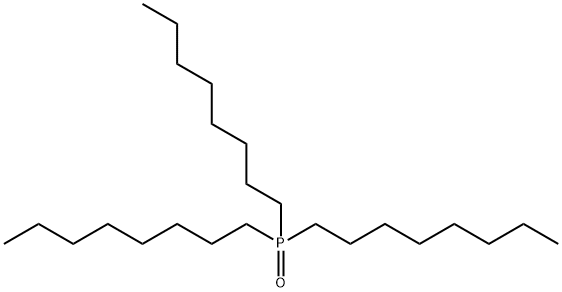
Триоктилфосфиноксид
- английское имяTrioctylphosphine oxide
- CAS №78-50-2
- CBNumberCB3268225
- ФормулаC24H51OP
- мольный вес386.63
- EINECS201-121-3
- номер MDLMFCD00002083
- файл Mol78-50-2.mol
| Температура плавления | 50-52 °C(lit.) |
| Температура кипения | 201-202 °C2 mm Hg(lit.) |
| плотность | 0,88 g/cm3 |
| давление пара | 0.004Pa at 50℃ |
| Fp | >230 °F |
| температура хранения | Store below +30°C. |
| растворимость | <1g/l |
| форма | Crystalline Powder, Crystals or Flakes |
| цвет | White to slightly yellow |
| Растворимость в воде | Insoluble |
| БРН | 1796648 |
| Стабильность | Stable. Incompatible with strong oxidizing agents. |
| LogP | 9.54 |
| Справочник по базе данных CAS | 78-50-2(CAS DataBase Reference) |
| Рейтинг продуктов питания EWG | 1 |
| FDA UNII | EXU8U2AM5A |
| Система регистрации веществ EPA | Phosphine oxide, trioctyl- (78-50-2) |
| UNSPSC Code | 12352119 |
| NACRES | NA.22 |
| Коды опасности | Xi,Hazard | |||||||||
| Заявления о рисках | 38-41-50/53-34 | |||||||||
| Заявления о безопасности | 26-36/39-39-61-60-45-36/37/39 | |||||||||
| РИДАДР | 3261 | |||||||||
| WGK Германия | 2 | |||||||||
| RTECS | SZ1662500 | |||||||||
| Температура самовоспламенения | 270 °C | |||||||||
| TSCA | Yes | |||||||||
| Группа упаковки | II | |||||||||
| кода HS | 29310095 | |||||||||
| кода HS | 32019090 | |||||||||
| Токсичность | LD50 orally in Rabbit: > 10000 mg/kg LD50 dermal Rat 2830 mg/kg | |||||||||
| NFPA 704: |
|
рисовальное письмо(GHS)
-
рисовальное письмо(GHS)

-
сигнальный язык
опасность
-
вредная бумага
H315:При попадании на кожу вызывает раздражение.
H318:При попадании в глаза вызывает необратимые последствия.
H412:Вредно для водных организмов с долгосрочными последствиями.
-
оператор предупредительных мер
P264:После работы тщательно вымыть кожу.
P273:Избегать попадания в окружающую среду.
P280:Использовать перчатки/ средства защиты глаз/ лица.
P302+P352:ПРИ ПОПАДАНИИ НА КОЖУ: Промыть большим количеством воды.
P305+P351+P338:ПРИ ПОПАДАНИИ В ГЛАЗА: Осторожно промыть глаза водой в течение нескольких минут. Снять контактные линзы, если Вы ими пользуетесь и если это легко сделать. Продолжить промывание глаз.
P332+P313:При возникновении раздражения кожи: обратиться за медицинской помощью.
Триоктилфосфиноксид химические свойства, назначение, производство
Химические свойства
white crystalline powderИспользование
Trioctylphosphine oxide (TOPO) is most commonly used as the solvent due to its high boiling point and chemical stability, and its ability to prevent particle aggregation via coordination to the NP surface. trioctylphosphine oxide is a frequently used surfactant, starts to decompose at around 425°C.The industrial applications of trioctylphosphine oxide, make use of its complexing powers with metals and with hydrogen donor organic compounds. Commercial uses as a solvent extraction reagent are in the recovery of uranium from wet process phosphoric acid and in the recovery of byproduct acetic acid and furfural generated during sulphite wood pulping.
TOPO is a widely used chemical compound in nanocrystal synthesis, for the removal of heavy metals, and the removal of toxins in waste water. TOPO is often used as a ligand stabilizer for colloids in traditional thermal decomposition synthetic techniques.
trioctylphosphine oxide became a nearly irreplaceable solvent (mp 51-52°C) for high-temperature preparation of various type of nanocomposites. TOPO has a very high boiling point (411°C) which is an important prerequisite for the homogeneous nucleation and good crystallinity of the nanoparticles.
Общее описание
Visit our Sensor Applications portal to learn more.Методы очистки
Mason, McCarty and Peppard [J Inorg Nuclear Chem 24 967 1962] stirred a 0.1M solution in *benzene with an equal volume of 6M HCl at 40o in a sealed flask for 48hours, then washed the *benzene solution successively with water (twice), 5% aqueous Na2CO3 (three times) and water (six times). The *benzene and water were then evaporated under reduced pressure at room temperature. Zingaro and White [J Inorg Nucl Chem 12 315 1960] treated a pet ether solution with aqueous KMnO4 (to oxidise any phosphinous acids to phosphinic acids), then with sodium oxalate, H2SO4 and HCl (to remove any manganese compounds). The pet ether solution was slurried with activated alumina (to remove phosphinic acids), filtered, evaporated and the residue was recrystallised from pet ether or cyclohexane at -20o. It can also be recrystallised from EtOH. [Beilstein 4 IV 3466.]Триоктилфосфиноксид поставщик
| поставщик | телефон | страна | номенклатура продукции | благоприятные условия | |
|---|---|---|---|---|---|
| +86-27-87465837 +8618971612321 |
China | 9639 | 58 | ||
| +86 13288715578 +8613288715578 |
China | 12825 | 58 | ||
| +86-13131129325 | China | 5887 | 58 | ||
| +8617732866630 | China | 18147 | 58 | ||
| +86-371-86557731 +86-13613820652 |
China | 20259 | 58 | ||
| +86-371-66670886 | China | 19902 | 58 | ||
| +86-86-02137122233 +8613795318958 |
China | 299 | 55 | ||
| +86-0371-55170693 +86-19937530512 |
China | 21632 | 55 | ||
| +86-0571-85586753; +8613336034509 |
China | 1376 | 60 | ||
| +86-0371-86658258 +8613203830695 |
China | 29871 | 58 |
Триоктилфосфиноксид Обзор)
1of4